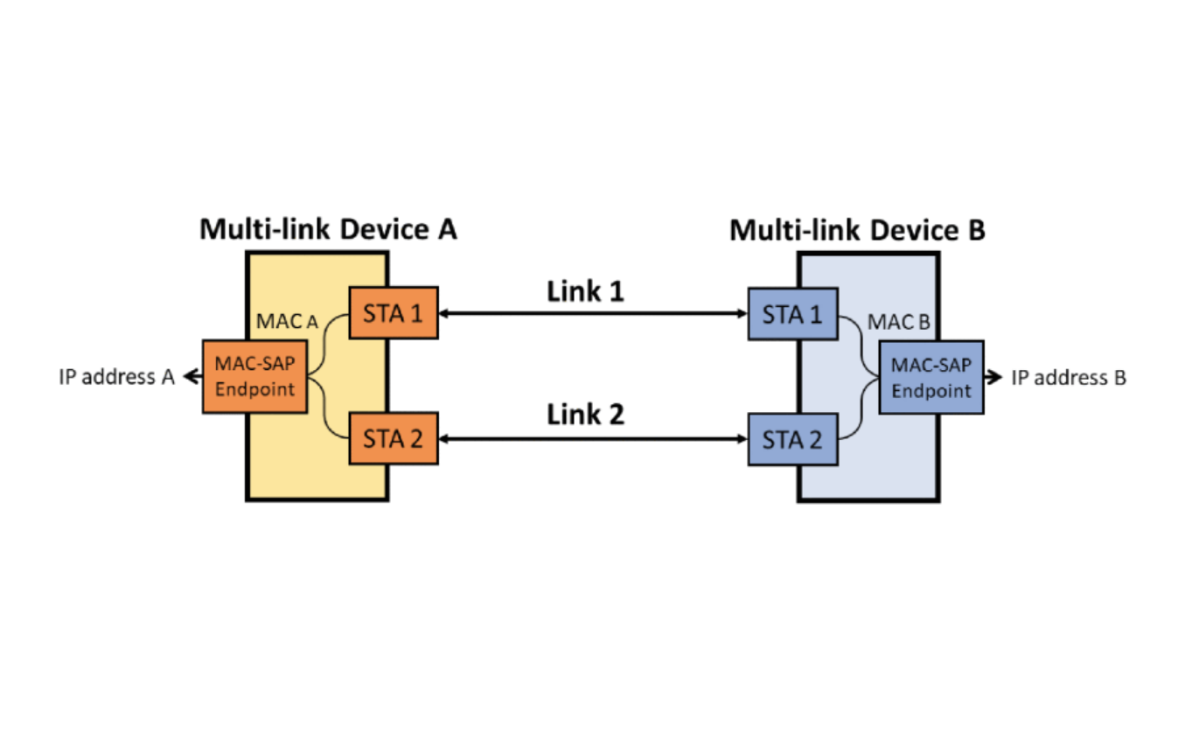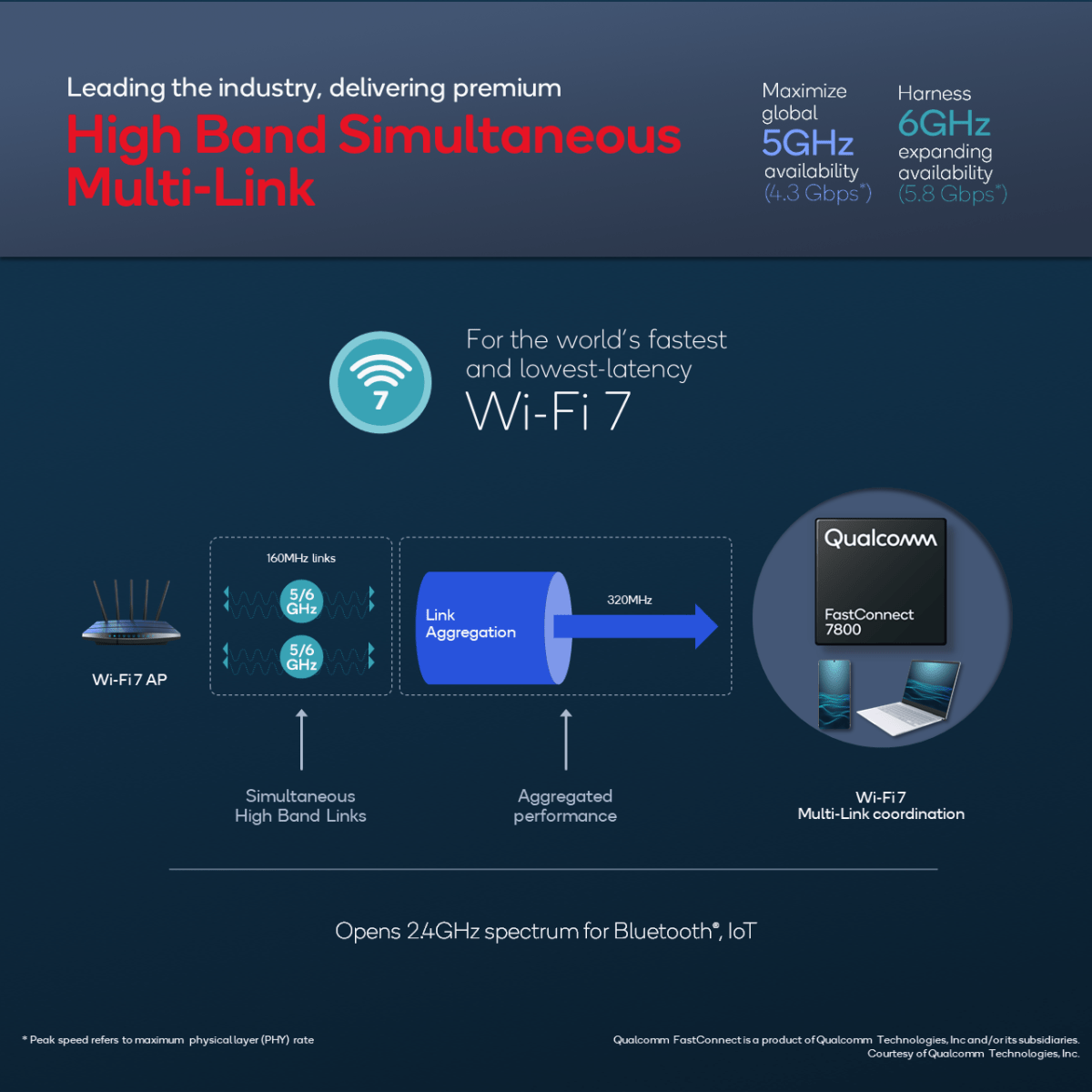Move over, Wi-Fi 6E! Chip vendors like Qualcomm are beginning to make plans for Wi-Fi 7, the next generation of Wi-Fi technology. Qualcomm said Monday at Mobile World Congress 2022 that it plans to launch the world’s first Wi-Fi 7 chip, the FastConnect 7800, as part of its new premium Snapdragon Connect specification by the end of 2022.
The Wi-Fi 7 specification, also known as 802.11be Extremely High Throughput (or just 802.11be), isn’t even close to being completed — the IEEE’s current paper on the current status of 802.11be calls for the standard’s ratification sometime in 2024. But as with previous Wi-Fi standards, that isn’t stopping vendors from developing silicon based upon draft releases, tweaking them via firmware or other updates as the specification moves through its final approval process.
Yes, Wi-Fi 7 will be faster, in part because of wider channel widths. But the key improvement Wi-Fi 7 makes is how it smartly uses what earlier Wi-Fi versions have already provided it.
What is Wi-Fi 7? The short answer
Wi-Fi 7 will significantly increase Wi-Fi bandwidth. How much? According to the IEEE, the maximum nominal throughout of Wi-Fi 7 is 46Gbit/s, 4.8 times faster than Wi-Fi 6 and slightly faster than the 40Gbits/s delivered by a Thunderbolt 3/4 connection.
In the real world, the numbers will be lower. According to Mike Roberts, the global vice president for product marketing at Qualcomm, the FastConnect 7800 will reach real-world throughput speeds of 5.8 gigabits per second, 60 percent more than the previous (Wi-Fi 6E) generation. The average latency will be less than two milliseconds, or 60 percent faster than the previous generation, he said. Mediatek, which also recently demonstrated Wi-Fi 7 in action, claims that it’s 2.4 times faster than Wi-Fi 6.
How Wi-Fi 7 improves the overall experience, however, is both cooler as well as a bit more complicated.
Wi-Fi 7: faster, smarter, and with far less lag
Wi-Fi 6 was optimized for congestion and wireless efficiency, enabling your router to effectively communicate with dozens of wireless devices. Wi-Fi6E weaved in a dedicated 6GHz frequency, adding additional channels for high-bandwidth devices like mesh routers to communicate with one another. If you think of wireless communication as lanes on a freeway, WiFi 6E effectively added a dedicated HOV or commuter lane, allowing high-priority buses and ambulances their own traffic-free channel.
In the real world, though, cars moving down a freeway can re-route themselves to avoid congestion. Until now, Wi-Fi couldn’t. A Wi-Fi 6 router can communicate data on both the 2.4-GHz, 5-GHz, and 6-GHz channels simultaneously, but they’re all independent of one another.
Wi-Fi 7’s most significant improvement is that it transforms the router into a multi-link device. Several physical radios can communicate on separate frequencies, yet Wi-Fi 7 ties them all together underneath a single MAC interface so that an Xbox or a smart speaker simply sees a single device. A Wi-Fi 7 router can simply assign data packets to whatever frequency channel is the least congested, because it simply doesn’t care which frequency it uses.

Put another way, the days of manually configuring a device to be “on” a 2.4-GHz or 5-GHz network appear to be over. Wi-Fi 7 will simply choose which frequency band has the lowest congestion, and send the data over that channel. Qualcomm calls this Alternating Multi-Link, where devices will simply switch back and forth between the available bands. Bouncing back and forth between channels also has implications for power saving, too, according to the IEEE.
In a case where a Wi-Fi 7 router is only “talking” to another device, there’s another option that Qualcomm calls “High Band Simultaneous Multi-Link.” With it, all bands are used simultaneously to blast data across all available radio frequencies. That means what it says; Wi-Fi 7 devices won’t necessarily communicate on, say, a 6GHz channel, they’ll be able to theoretically communicate on all three, at once. (Practically, that won’t happen; the 2.4GHz band will continue to be reserved for slower IoT devices. In the Qualcomm FastConnect 7800, HBS Multi-Link combines four streams across the two 5-and 6-GHz radios, Qualcomm said.)

Qualcomm
In part, this takes advantage of an additional feature: Wi-Fi 7’s wide-channel spectrum use. According to Qualcomm, Wi-Fi 7 widens the maximum available channel width from 160MHz to 320MHz — a wider channel band equals more available throughput.
The kicker, however, is that the 320MHz channel isn’t always available. Instead, Wi-Fi 7 can combine two 160MHz channels in the high (5 and 6-GHz) bands to create an effective 320MHz data channel. Wi-Fi 7 can use then these channels as it chooses, such as using one radio for communicating to a device, and another for receiving data. Wi-Fi 7 also incorporates “preamble puncturing,” which is a more aggressive way of handling interference, according to Qualcomm. If a Wi-Fi 7 router is trying to connect to a channel that’s partially interfered with, the router doesn’t give up. Instead, it simply grabs the channel bandwidth that’s not being interfered with. The upshot is that Wi-Fi 7 will more efficiently use data.
Wi-Fi 7 also includes 1024-QAM, a way of effectively increasing the throughput by increasing the number of bits communicated by the analog signal — about 25 percent more data than the 256-QAM of Wi-Fi 5, according to the IEEE.
There’s one big additional benefit. From Qualcomm’s perspective, a Wi-Fi 7 router that can intelligently pick channels also significantly reduces wireless latency or lag. That will be perfect for gaming or for Qualcomm’s AR/VR ambitions, which demand latency-free video to prevent vertigo. We don’t know how this will play out, but in a world moving to cloud gaming and VR, reduced latency may be the most significant addition of all.
Snapdragon Connect
The Qualcomm FastConnect 7800 will be part of what Qualcomm calls Snapdragon Connect, which will be the premium brand for all of Qualcomm’s connection technologies. “Devices that conform with Snapdragon Connect will ship with our best 5G, Wi-Fi and Bluetooth,” Roberts said. “This is going to enable faster, more responsive, more reliable, connected experiences. When a device has Snapdragon Connect, it will feature a comprehensive suite of our technologies from our baseband to [the] antenna system.”

Qualcomm
That suite will include the Snapdragon X70, Qualcomm’s newest 5G modem, which features “AI-powered optimizations of both sub-6GHz and millimeter wave links for improved speeds, coverage, mobility and link robustness,” Roberts added. “The X70 inherits the 10 Gbps 5G peak download speed record from its predecessor and introduces new features such as switched uplink, enabling 3.5 Gbps peak upload speeds in more networks globally,” Qualcomm said.
It will also include what Qualcomm calls “Advanced Bluetooth Audio,” two radios with enhanced connections, allowing Bluetooth accessories to work with twice the range and pair in half the time.
Finally, Qualcomm also announced the Lenovo ThinkPad X13S, which will be the first to use the new Snapdragon 8cx Gen 3. The Snapdragon Connect-qualified laptop will feature a whopping 28 hours of battery life, Roberts said.
All of these may be Qualcomm’s own specific announcements, certainly. But a new generation of wireless technology for all of us appears to be right over the horizon.




